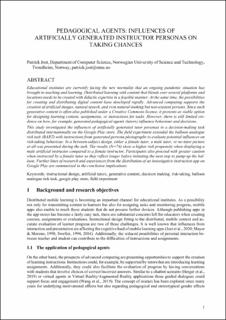| dc.contributor.author | Jost, Patrick | |
| dc.date.accessioned | 2021-01-26T09:59:42Z | |
| dc.date.available | 2021-01-26T09:59:42Z | |
| dc.date.created | 2020-11-25T21:17:11Z | |
| dc.date.issued | 2020 | |
| dc.identifier.citation | NIKT: Norsk IKT-konferanse for forskning og utdanning. 2020, (4), 1-14. | en_US |
| dc.identifier.issn | 1892-0713 | |
| dc.identifier.uri | https://hdl.handle.net/11250/2724732 | |
| dc.description.abstract | Educational institutes are currently facing the new normality that an ongoing pandemic situation has brought to teaching and learning. Distributed learning with content that blends over several platforms and locations needs to be created with didactic expertise in a feasible manner. At the same time, the possibilities for creating and distributing digital content have developed rapidly. Advanced computing supports the creation of artificial images, natural speech, and even natural-looking but non-existent persons. Since such generative content is often also published under a Creative Commons license, it presents as viable option for designing learning content, assignments, or instructions for tasks. However, there is still limited evi-dence on how, for example, generated pedagogical agents (tutors) influence behaviour and decisions. This study investigated the influences of artificially generated tutor personas in a decision-making task distributed internationally on the Google Play store. The field experiment extended the balloon analogue risk task (BART) with instructions from generated persona photographs to evaluate potential influences on risk-taking behaviour. In a between-subject design, either a female tutor, a male tutor, or no tutor picture at all was presented during the task. The results (N=74) show a higher risk propensity when displaying a male artificial instructor compared to a female instructor. Participants also proceed with greater caution when instructed by a female tutor as they reflect longer before initiating the next step to pump up the bal-loon. Further lines of research and experiences from the distribution of an investigative instruction app on Google Play are summarised in the conclusive implications. | en_US |
| dc.language.iso | eng | en_US |
| dc.publisher | Bibsys Open Journal Systems | en_US |
| dc.relation.uri | https://ojs.bibsys.no/index.php/NIK/article/view/825 | |
| dc.subject | Brukergrensesnitt | en_US |
| dc.subject | Human-Computer Interaction | en_US |
| dc.subject | IT i utdanning og læring | en_US |
| dc.subject | Educational technology | en_US |
| dc.subject | Mediapsykologi | en_US |
| dc.subject | Media Psychology | en_US |
| dc.subject | Serious Games | en_US |
| dc.subject | Serious Games | en_US |
| dc.title | Pedagogical agents: Influences of artificially generated instructor personas on taking chances | en_US |
| dc.type | Peer reviewed | en_US |
| dc.type | Journal article | en_US |
| dc.description.version | publishedVersion | en_US |
| dc.subject.nsi | VDP::Datateknologi: 551 | en_US |
| dc.subject.nsi | VDP::Computer technology: 551 | en_US |
| dc.source.pagenumber | 1-14 | en_US |
| dc.source.journal | NIKT: Norsk IKT-konferanse for forskning og utdanning | en_US |
| dc.source.issue | 4 | en_US |
| dc.identifier.cristin | 1852526 | |
| dc.relation.project | Norges forskningsråd: 270969 | en_US |
| dc.description.localcode | Published by Bibsys Open Journal Systems. https://ojs.bibsys.no/index.php/NIK/article/view/825 | en_US |
| cristin.ispublished | true | |
| cristin.fulltext | original | |
| cristin.qualitycode | 1 | |
